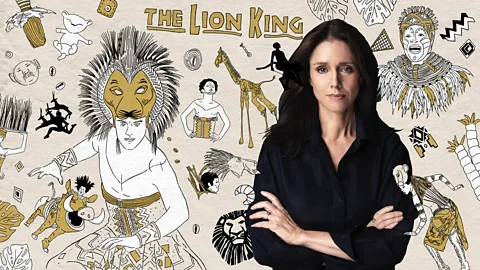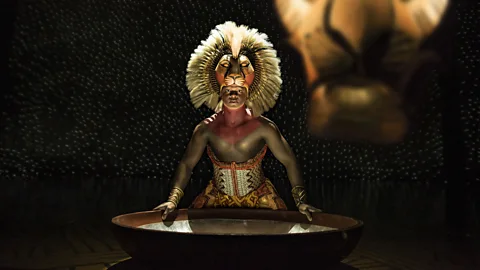'I got major doubt from the movie guys': Julie Taymor on turning The Lion King into the most successful musical ever
 Emmanuel Lafont
Emmanuel LafontDisney's stage version of their hit film is an unmatched global phenomenon. Twenty-seven years on from its premiere, its director discusses why it was a big risk that paid off 10 billion-fold.
The Lion King musical is a beast of a show – captivating US audiences since 1997, it is the highest-grossing production of all time, in theatre or in film, taking over $10 billion (£7.68 billion) worldwide. It's currently celebrating 25 years in the West End, hits 27 years on Broadway next month, and has been staged all around the world – from South Africa to South Korea, Australia to the United Arab Emirates – visiting every continent except Antarctica. "The penguins don't need us," quips Julie Taymor, the theatre, film and opera director and designer whose unique vision helped the musical spring into life on stage – proving that theatrical versions of Disney movies could not only be hugely profitable, but could do so while being artistically inventive in their own right.
Warning: This article contains language that some may find offensive
But when Disney initially approached her about directing a live version of their adored 1994 cartoon film, Taymor didn't know what to say: she hadn't actually seen The Lion King. "I thought, well, why not, let's go look at the movie," the still youthful-looking 71-year-old recalls, speaking to me via Zoom from the US. "And I was really taken; I loved it." The challenge of adapting an epic, wide-screen story excited her: how, she recalls wondering, would you put hundreds of animals on stage? How could you create a stampede of wildebeest live in front of an audience?
 Disney
DisneyThe answer was by embracing a distinctly theatrical approach: The Lion King uses masks and puppetry to put the animals of the African savannah onstage, and to tell the coming-of-age story of Simba the lion, from cub to king. Taymor designed all the costumes and masks, and the breakthrough moment was deciding to let the audience see the mechanics of how each character is made – to invite them to suspend their disbelief, and to use their imagination in helping create that whole world onstage.
"I went through every animal: okay, we've got a giraffe, I'll put the neck on top of the head of the dancer, but you're going to see the dancer's face, you're going to see where the stilts are wrapped to the dancer's hands…" re Taymor gleefully. "There is no attempt to hide the human being behind the masks or inside the puppet," she says, a technique she dubbed the "double event", allowing performers to be both animal and human simultaneously.
So you can see Simba's emotion on the actor's face, while a mask on top of his head reminds the audience that this is, in fact, a lion; Timon the meerkat is a puppet, drawing on the Japanese Bunraku puppetry tradition where you can fully see the person behind him, controlling his movements. Trays of grasses on performers' heads evoke swaying grasslands, while whole flocks of gazelles are created by a chorus wearing puppets on their heads and arms at the same time.
"I wanted to do what theatre does best,” recalls Taymor. "Film hides the strings: we know it's fake, but we're pretending that it's really there – that the Titanic is really on the ocean, that it's really sinking. Whereas in the theatre, we will enjoy seeing a little puppet of a boat, and a big ocean of silk… this is the power of theatre. The audience is not played down to – they're brought into the game."
A visionary choice
Today, it's hard to imagine The Lion King being done any other way – but it wasn't all smooth sailing. And even getting the call from Disney was a surprise to start: while Taymor had already made a name for herself within theatrical circles – her musical fable about a jaguar cub who transforms into a boy in the Uruguay jungle, Juan Darién, had netted five Tony nominations in 1996. But aside from that big cat connection, her work's distinctly international flavour and its heavy use of masks and puppetry inspired by Indonesian and Japanese traditions didn't necessarily scream family-friendly commercial juggernaut. Nonetheless, Thomas Schumacher, the new head of Disney Theatricals, had a hunch Taymor's highly visual style of theatre could be just the thing to bring The Lion King to the stage.
It wasn't the first live Disney musical – that was Beauty and the Beast, also a commercial success, running on Broadway for 13 years. But it didn't win much love from theatre critics; Variety was not unusually harsh in dubbing it "bloated, padded, gimmick-ridden, tacky and, despite the millions, utterly devoid of imagination". It was widely seen as a cash-in – more like an extension of Disneyland than an imaginative piece of art in its own right.
 Disney
DisneyIt would be a very different story with The Lion King – which the New York Times immediately praised on its 1997 world premiere as being "miles away from standard Disney fare". Yet Taymor recalls that, from the very beginning, the head honchos at Disney were remarkably open to whatever ideas she cooked up. "They didn't actually have a very strong idea at all about how to do this, which was quite great – it left the door wide open." The door was so wide, in fact, that they weren't even sure The Lion King would be a Broadway musical; as Taymor recalls, early discussions kicked around the idea of a stadium show, or something at a planetarium.
Julie Taymor's Five Culture Shifters
Akira Kurosawa – Rashomon (1950)
I go back to when I saw my first "foreign film" in Paris, when I was 15 years old. I watched Rashomon and that changed my life. Kurosawa! He is the reason, his movies are the reason, that I became a film director.
Peter Brook – A Midsummer Night's Dream (1970-71)
I being at Oberlin College and taking a bus 15 hours with my fellow schoolmates to New York to see Peter Brook's Dream. It had a powerful effect on me.
Elka and Peter Schumann – Bread and Puppet Theatre (1963-)
During the Vietnam war, when I was in high school, I became very aware of Bread and Puppet Theatre – Peter Schumann's giant puppets that were used as political protest in marches in the streets of New York and Washington. The power of puppetry was really apparent.
Federico Fellini – Nights of Cabiria (1957)
One of my favourite filmmakers, I love Fellini's sensibility and love of life.
Various – Indonesian theatre including Javanese shadow puppetry
I have never seen theatre as potent, powerful, and overwhelmingly theatrical as I have in Indonesia. It's part of the everyday fabric of society.
But Taymor does recall how an early workshop showcasing the "double event" mask concept spooked some of the money men. Michael Eisner, Disney's chief executive, Joe Roth, the studio chief, and what Taymor describes as "a bunch of the top people at Disney – but not theatre people" all came to see what she was cooking up. But the masks were too big; the costumes were unfinished; one of the puppeteers seemed determined to upstage his own puppet… "I got major doubt from the movie guys," its Taymor.
Her response was: "OK, let's do a test – because I don't want doubt, and I have nothing to sell. If you don't think the puppetry and the double event masks are right, we'll do something else." She put together three different, fully realised visions for The Lion King: a commedia dell'arte approach, with half masks that were smaller and more human; a Cats-style version, with face-paint, and her double event approach, with the masks on the head.
"All three worked," says Taymor. "So I said to Michael Eisner 'which one do you want">window._taboola = window._taboola || []; _taboola.push({ mode: 'alternating-thumbnails-a', container: 'taboola-below-article', placement: 'Below Article', target_type: 'mix' });
